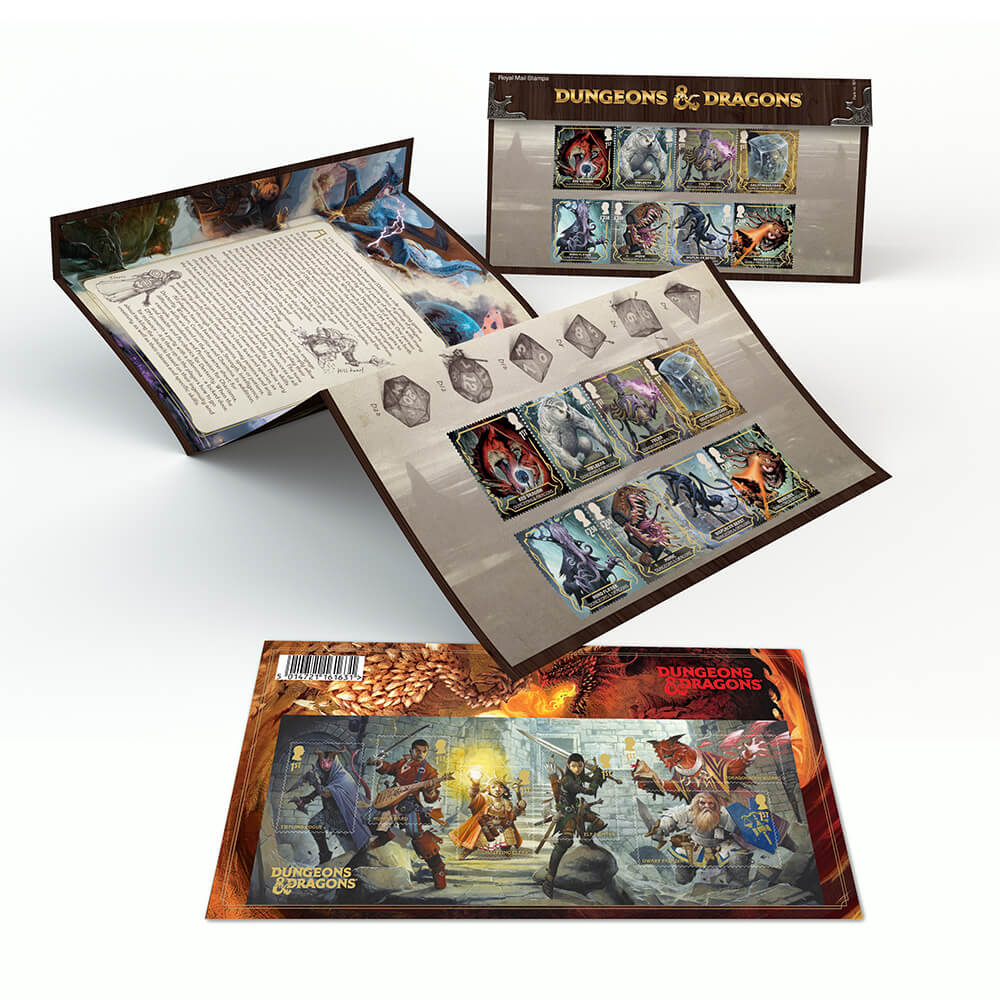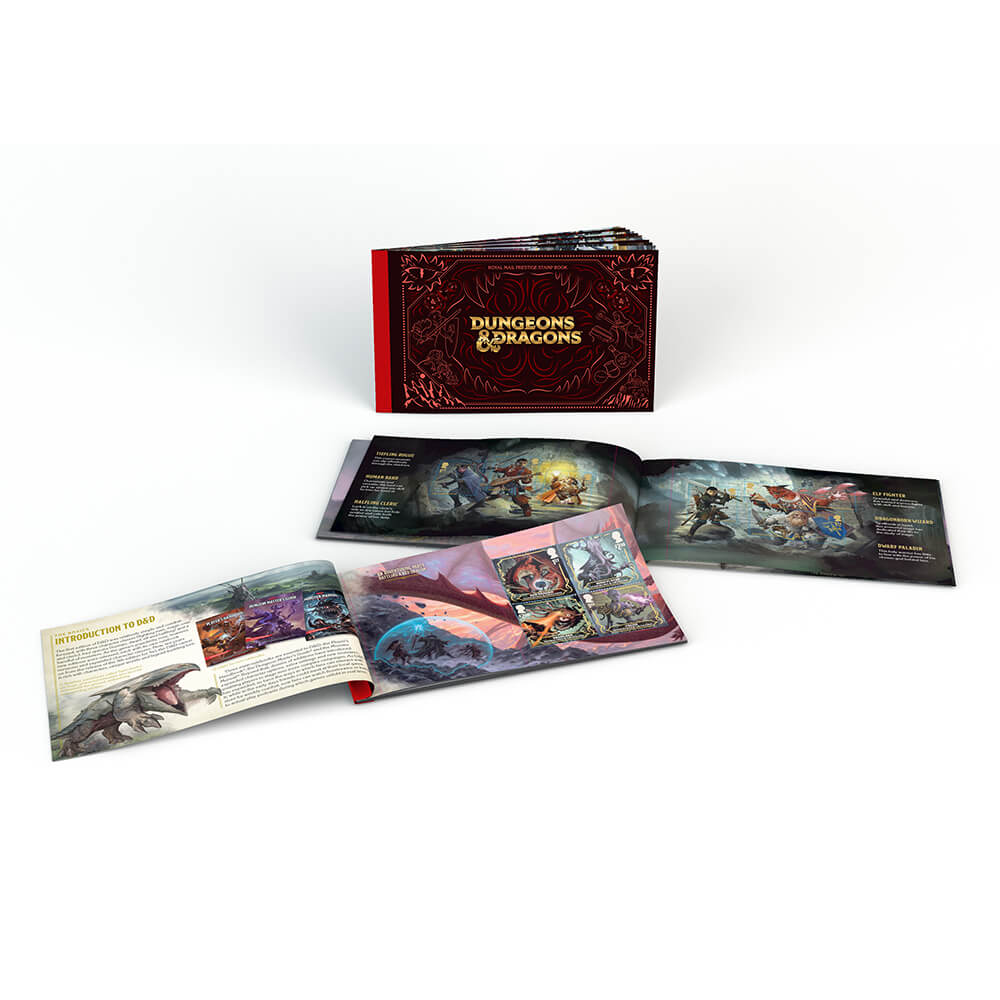Our most adventurous stamp issue yet
Discover more about our epic new stamps and collectibles range, celebrating 50 years of the trailblazing roleplay game DUNGEONS & DRAGONS.
When did you get into D&D? Does gaming influence your work? What is it you love about the game?
The focus of my art during my teenage years was pretty much fantasy, sci-fi or comic-related.
I started playing D&D in the early 1980’s after discovering the miniatures. I thought the miniatures were cool before realising that they were part of a totally new type of game. There was nothing like it at the time. But it did allow a massively creative outlet for my imagination.
Which artist(s) did you admire when you were growing up?
My major artistic influences as a teenager were artists featured in the 2000AD comic. Namely; Alan Davis, Dave Gibbons, Steve Dillon, Mike McMahon and Cam Kennedy.
That dynamic comic-style and exaggerated forms was extremely formative and significantly shaped the way I create art. That comic influence has remained a constant aspect in my work throughout the years, even when it comes to illustrating high fantasy subject matter.
At the time I began working on D&D my artistic influences had included;
The line-work of Alphonse Mucha and Mike Mignola.
The realism of fantasy artists Boris Vallejo, Larry Elmore, Clive Caldwell and Keith Parkinson.
The style of Brom.
I was never really able to emulate the realistic style of Boris, Larry, Clive and Keith. So my art kind of evolved into a stylized combination of pseudo-realism and comic form by accident rather than intent. However, it seems my style of creating artwork makes it much easier to be instantly recognizable to many RPG (Role-playing Games) players.
What do you like/admire about D&D fans?
Their enthusiasm!
There have been times when I’ve attended a large games convention and walked into some of the massive gaming halls filled with people playing RPGs. I get such a positive feeling from the good atmosphere that’s created by an increasingly diverse group of people just enjoying playing the game they love. That positive atmosphere is often felt throughout the rest of the convention.
How long have you been illustrating for D&D and how did you get started?
I’ve been illustrating D&D since 1997. A good friend of mine showed my work to art editor Dawn Murin at Wizards of the Coast. Dawn decided to give me a chance. Since then, I’ve created a multitude of interior images and cover art for D&D as well as many other tabletop games within the industry.
Why did you want to design these stamps for Royal Mail?
Being asked to design the D&D stamps for Royal Mail was a massive honour for me. As a British artist it was a wonderful opportunity to be able to contribute artwork that I’d created as a long-running D&D fantasy artist to something I consider to be an iconic institution. I get the opportunity to see my artwork on stamp!
There was also another reason why I was so keen to accept this particular commission and why it became so important for me. Because my Dad was a keen stamp collector. And I knew it’d mean a lot to him to know that his son had created artwork for stamps. However, shortly after undertaking the commission my Dad was diagnosed with late-stage lung cancer. Taking into account the strict non-disclosure agreements regarding the work involved on the project, I was able to show Dad some of the sketches I’d done and confide what they were going to be used for. Sadly, he passed away before the painted versions were finished. So, I’m dedicating the artwork I produced for these stamps to the memory of my Dad – Terry.
Can you describe your creative process?
An art commission usually consists of a number of stages. Each stage requires approval from the client before commencing the next stage. There can be a differing number of stages of development, depending upon the commission.
The first stage is sketch. This can comprise of two iterations. Sometimes a very loose composition sketch is submitted which just consists of basic lines and shapes just to show the general idea of what the image is going to look like and where all the elements are going to be positioned. The composition sketch doesn’t usually contain much in the way of detail. The detailed sketch is the next stage. This is usually a pencil sketch to show the detail of what will be depicted before colour is applied. Some artists keep these sketches quite loose. But my sketches are usually quite detailed.
The next stage is sometimes a colour rough which gives an indication of what colours are going to be used. This stage is not always necessary and many artists will proceed straight to the painted version upon approval of the detailed sketch.
How did designing for stamps differ to other projects you’ve worked on?
What differed from designing stamps to normal commissions is the precision involved in placing the image within stamp-sheet parameters. Artwork used on stamps needs to take into account the monarch’s head and monetary value of the stamp. This isn’t too much of a problem to work with. However, the positioning of elements on the miniature sheet becomes crucial. All depicted elements need to fit within given stamp dimensions and then positioned within a workable distance apart from each other and the edge of the image to allow the stamps to be cut.
The distancing becomes an issue when the sketch moves from its compositional stage to the detailed stage, because elements can change quite significantly when detail starts being added. Sometimes detail will result in a weapon or costume element drastically changing shape. Sometimes a pose needs to change or the placing of elements needs to change due to addition of detail. There are occasions where one thing being changed leads to multiple other aspects requiring adjustment to compensate for the initial change’s effect on the composition. I found that a number of aspects in the detailed sketch no longer fit within the stamp parameters required for the miniature sheet. There were so many changes required that it was easier to start the sketch completely from scratch so that all of the characters and equipment would fit into the placement of the stamps.
Did you work from existing images or are these original designs?
Only three of the images are taken from existing pieces of D&D artwork. The displacer beast from the 2010 DM’s Deluxe Screen. The red dragon from the cover of the 4th edition Dungeon Master’s Guide and the beholder from an unspecified D&D product cover. The gelatinous cube, mimic, mind flayer, owlbear and Vecna were original designs created specifically to fit the format of the stamps.
Do you have a favourite illustration from the stamps?
I’m my own worst critic so my preferences are probably based on entirely different parameters. Consequently, I’d have to say that the mimic is probably my favourite on the basis that this is the first time I’ve had the opportunity to illustrate that particular monster!
How has your artwork evolved in recent years?
The aesthetic style of my art has remained pretty consistent throughout my career. It’s not been a conscious decision to do so, rather it’s been a reflection on how I fundamentally visually interpret the world around me and express my imagination. That consistency has Creating art is an ongoing learning process that’s likely to take a lifetime.
Aside from your amazing work on these special stamps, do you have any plans to celebrate 50 years of D&D?
Probably by playing D&D.
Delve a little deeper into this fantastic issue

Presentation Pack
A fact-packed fold-out souvenir containing the complete collection of 14 stamps, the Miniature Sheet and content chronicling the origins of the game.

Prestige Stamp Book
An exceptional 24 page publication packed with stunning artwork and featuring all 14 Dungeons & Dragons stamps.

Sheet Bundle
Save 10% on the Dungeons & Dragons Collectors Sheet, Owlbear Fan Sheet and Vecna Fan Sheet when purchased together.
TM & © 2024 Wizards of the Coast LLC.



